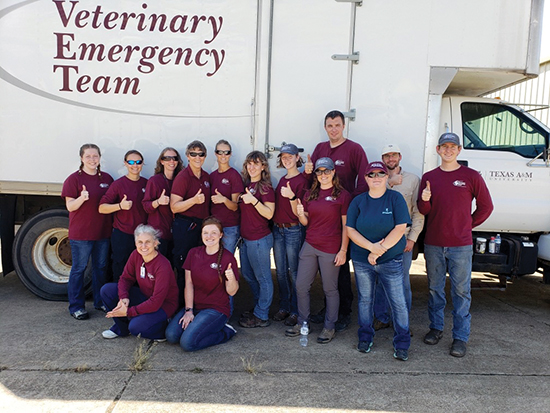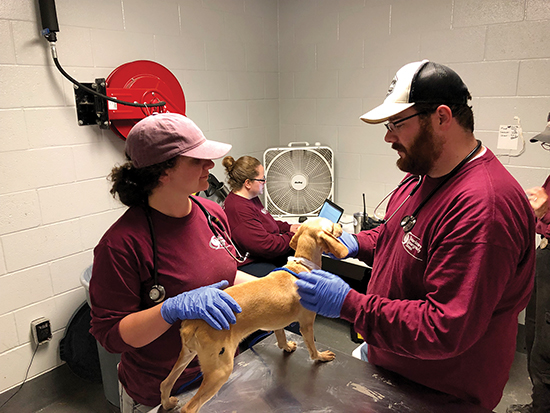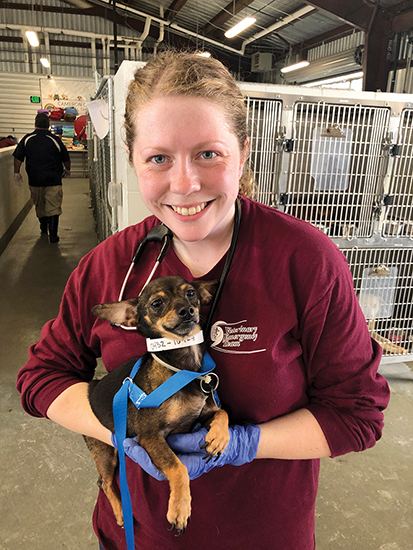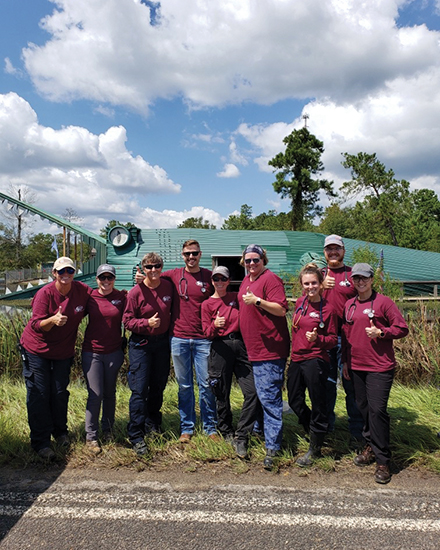Steady In The Storm
Story by Dorian Martin

Disasters that endanger animals come in many guises.
Some come in the form of natural disasters like Tropical Storm Imelda, which severely flooded 13 Texas counties in September 2019. In rural Chambers County alone, approximately 100 cattle, horses, dogs, and cats were rescued and/or treated for floodwater-related injuries. An additional 4,000 head of livestock were supported on site.
Other disasters come in the form of neglect.
Just prior to Tropical Storm Imelda, 270 dogs and one cat were recovered from an inhumane situation in South Texas’ Cameron County when authorities responded to complaints of loud barking. These animals, which were locked in a warehouse, needed to be evaluated and then receive proper attention before being offered for adoption.
Fortunately, Texas A&M’s Veterinary Emergency Team (VET) provides critical support during these times of extreme need across the state and nation.
Also, fortunately, for a dozen fourth-year veterinary students on the CVM’s Veterinary Emergency Management rotation, when the team deploys, the students deploy, too, giving them an educational opportunity like no other.
These students typically spend the Veterinary Emergency Management rotation, taught by VET faculty members, learning about the differences between general practice and emergency situations and then assisting communities with developing a disaster plan. If a crisis happens during their rotation, these students deploy to the emergency area and work with the VET to provide appropriate care.
Students who deploy get to see a different side of veterinary medicine.

“Deployment medicine is different because you’re not in the teaching hospitals, where resources are abundant, so you don’t have all of the capabilities you have there,” said Zachary Grimsley, who deployed to Cameron County. “But it also teaches you to be able to assess animals quickly and efficiently and to know that you don’t always have to have an X-ray machine and ultrasound right there at all times.”
During a major crisis, these students are assigned critical jobs that support the mission.
“The team has an integrated organizational structure with the available resources, equipment, and facilities to effectively respond to any disaster-related medical emergency,” said Lillian Maldonado Santiago, a fourth-year student who deployed to Chambers County. “We got experience with all of these things when we were divided into smaller groups (small vs. large animal-oriented), each with group leaders (veterinarians) to facilitate accountability and communication.”
A Flood Of Relief
Students learn that each disaster requires a specific response based on the type of emergency.
In the case of Imelda, many of the needs were based on dealing with the aftermath of severe flooding. Students were able to diagnose and treat submersion injuries, also known as “river rot,” which tend to adversely affect the skin and can lead to swelling and additional infection.

Students saw this when the team had to evaluate a group of ponies that were in floodwater for an unspecified amount of time. The large animal veterinarian did a visual exam to determine whether an animal needed immediate care. Once they were cleared, students decontaminated each pony and moved them to a clean sheltered area with access to food and water.
“Seeing this made me realize that there is no room to second guess yourself,” Santiago said. “Every decision needs to be made with confidence, as others are counting on these decisions in order to act accordingly.”
Human Kindness
The situation in Cameron County was completely different.
“While this disaster was unlike the usual deployment conditions the VET faces, it was a disaster in its own right,” said Sarah Brien, one of the CVM students who deployed. “When the county found them, the animals had been neglected and the community was overwhelmed by the volume of animals in need.”
Students’ problem-solving skills, clinical abilities, and resiliency were tested during this situation.
“We arrived at the Cameron County Animal Shelter with a rough plan of the triage system we wanted to execute,” Brien said. “However, the realities of the housing and behavior of the animals had to be accounted for in our updated plan.”
The revised plan required creating a better system to keep track of the overwhelming number of animals and maintain complete records. In addition, VET responders had to use innovative methods to deal with animal control issues.
“We had to handle the animals in a way that minimized their stress, which was challenging because they were not leash-trained; we also had to be aware of heat exhaustion issues,” Brien said. “We would quickly troubleshoot to find a better way of handling the animals that were resistant to leashes and moved patients into air-conditioned rooms or trucks for physical exams and medical care to decrease the risk of overheating for patients and VET members.”

Prepared For A Crisis
Ultimately, the CVM students on the Veterinary Emergency Management rotation benefited from the VET’s deployments as much as the animals that were served.
In the Cameron County deployment, each student performed full physical exams on more than 50 patients, administered vaccines, and drew blood for heartworm tests. They worked with both friendly and unruly animals that had suffered injuries, which required them to face the reality of abuse through the physical deterioration of a few animals.
The students believe that these types of deployments give them an understanding of the pressures of an emergency situation and how they could be called upon to respond when they have their own practice.
“Having emergency planning and response as a part of my veterinary education will make me a better veterinarian in the future,” Grimsley said. “I will be better equipped to serve my community during a time of emergency, should it arise. The memories and the skills I learned during my deployment will stick with me for the rest of my career, along with the feeling of being able to serve a greater cause.”
###
Note: This story originally appeared in the Spring 2020 edition of CVM Today.
For more information about the Texas A&M College of Veterinary Medicine & Biomedical Sciences, please visit our website at vetmed.tamu.edu or join us on Facebook, Instagram, and Twitter.
Contact Information: Jennifer Gauntt, Director of Communications, Texas A&M College of Veterinary Medicine & Biomedical Sciences; jgauntt@cvm.tamu.edu; 979-862-4216


